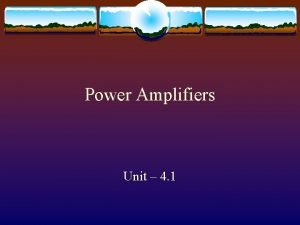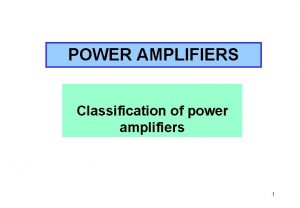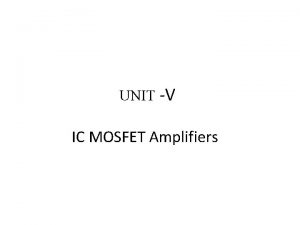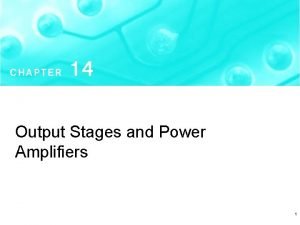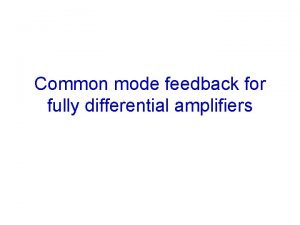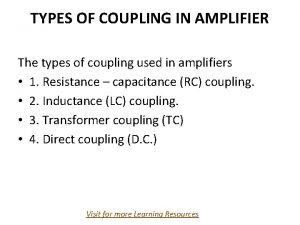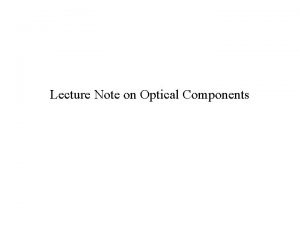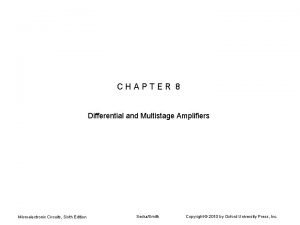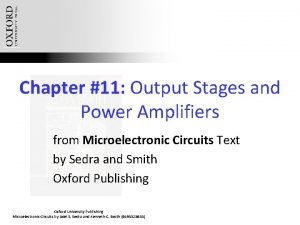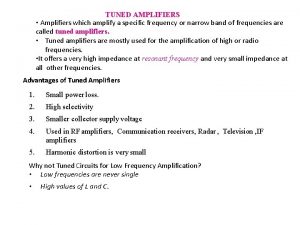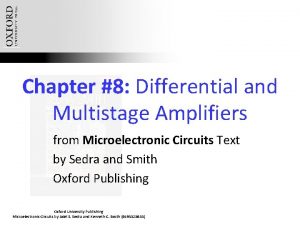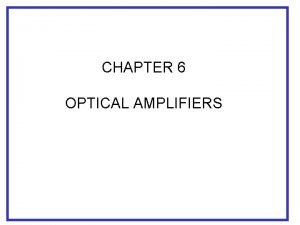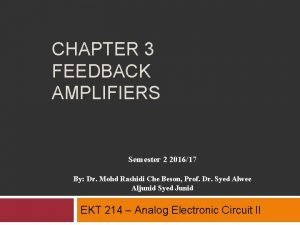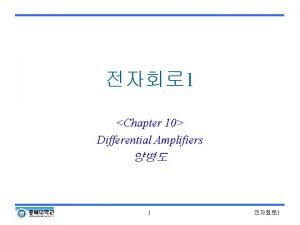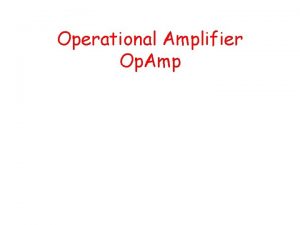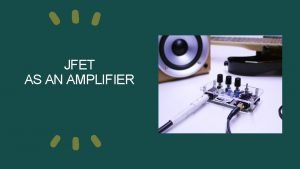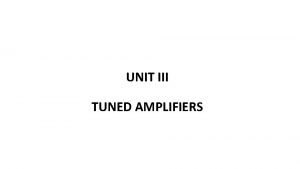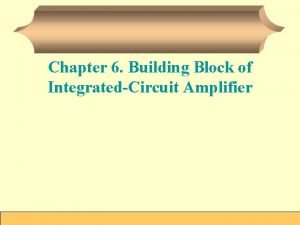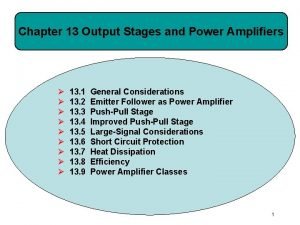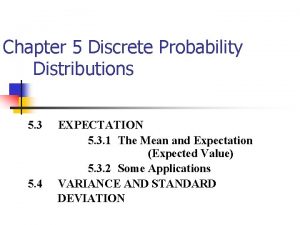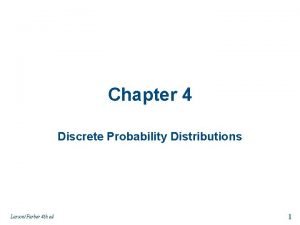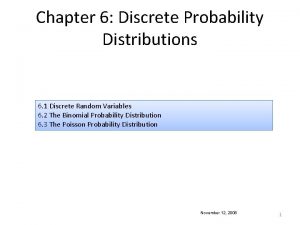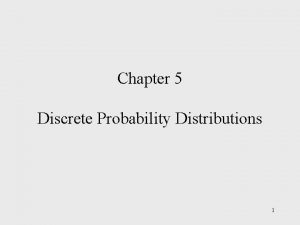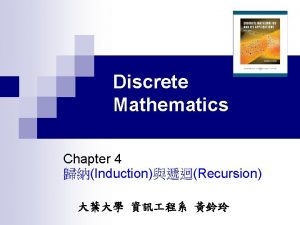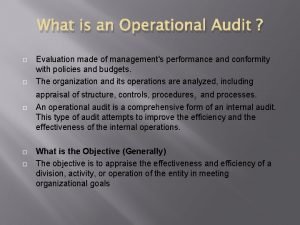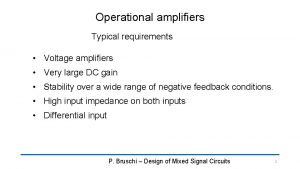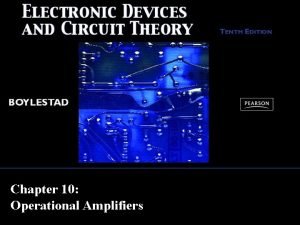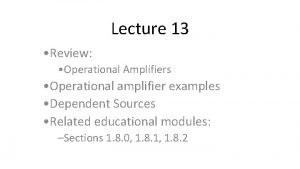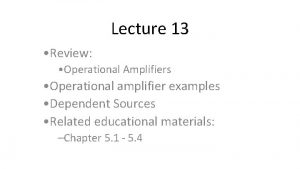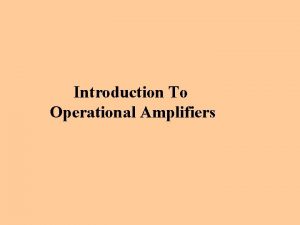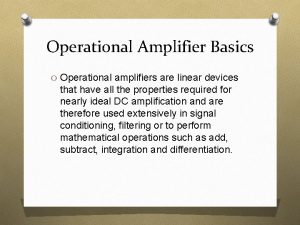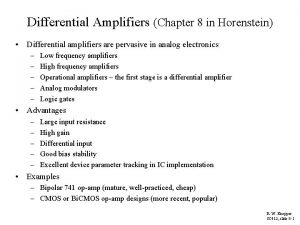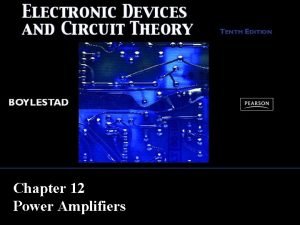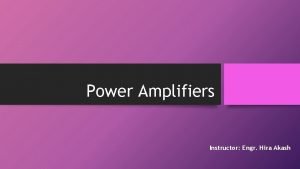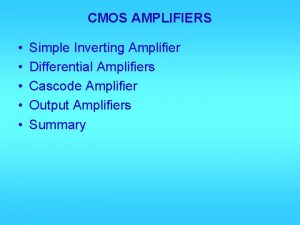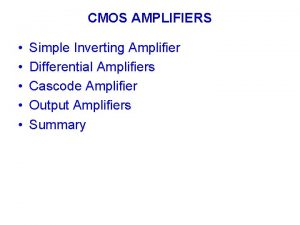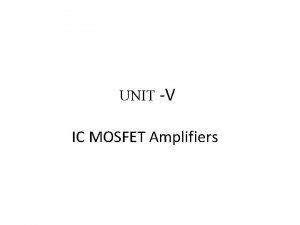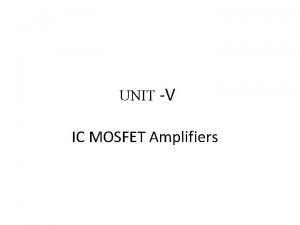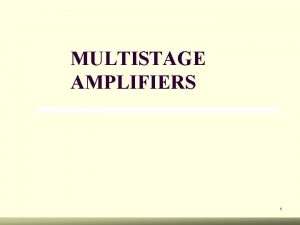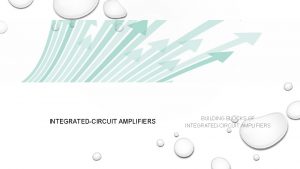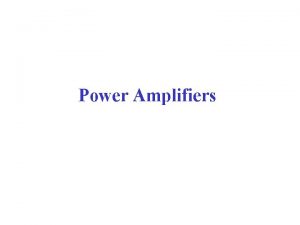Chapter 15 Operational Amplifiers Components n Discrete Components





































- Slides: 37

Chapter 15 Operational Amplifiers

Components n Discrete – Components housed in individual packages; that is, one package – one component. n n The traditional 2 N 3904 (TO 92 package) is an example. Integrated circuit (IC) – A single package that contains any number of active and/or passive components, all constructed on a single piece of semiconductor material. n The KA 741 operational amplifier is an example.

Operational Amplifier (Op-Amp) n Op-amp – A high-gain dc amplifier that has high input impedance and low output impedance. n n The inverting (–) input and noninverting (+) input are signal inputs. The +V and –V inputs are supply voltage inputs.

Op-Amp Supply Connections n Op-amp supply pins are connected n n To equal positive and negative supply voltages, or To one supply voltage and ground.

Differential Amplifier n n Differential amplifier – A circuit that amplifies the difference between two input voltages. The op-amp signal inputs are connected to a differential amplifier. n The circuit amplifies the difference between the voltages at its inverting (-) and noninverting (+) inputs.

Op-Amp Voltage Gain n Open-loop voltage gain (AOL) – The maximum possible voltage gain of a given op-amp. n n The term open-loop indicates that AOL is the voltage gain of an op-amp with no feedback path. Adding a feedback path to an op-amp (below) reduces the overall voltage gain to some value less than AOL.

Input/Output Polarity n n When the (+) input is the more positive of the two, the output is positive. When the (-) input is the more positive of the two, the output is negative.

Inverting and Noninverting Circuits n n Inverting input – The op-amp input that produces a 180° voltage phase shift (from input to output). Noninverting input – The op-amp input that does not produce a voltage phase shift (from input to output).

Output Voltage Curves n The limits on output voltage are determined primarily by load resistance and the supply voltages.

Basic Differential Amplifier

Differential Amplifier Input/Output Relationships

Modes of Operation n Differential amplifiers have three operating modes. n n n Single-ended mode – An active input is applied to one input only. Differential mode – Two active inputs are applied. The output reflects the relationship between the input signals. Common mode – Occurs when two identical signals are applied to the inputs simultaneously. The ideal differential has a 0 V output when common mode signals are applied. n Common-mode signals are usually undesired signals.

Output Offset Voltage n Output offset voltage – A voltage that may appear at the output for an op-amp, caused by an imbalance in the differential amplifier.

Input Offset Voltage n Input offset voltage – The difference between the base-emitter voltages in a differential amplifier that produces an output offset voltage when the signal inputs are grounded. n Input offset voltage is commonly represented as a battery connected to the op-amp inputs.

Eliminating Output Offset Voltage n n Input offset current – A slight difference in op-amp input currents, caused by differences in the transistor beta ratings. Compensating resistor – A resistor connected to the noninverting input to an op-amp to compensate for any difference in the input currents.

Input Bias Current n Input bias current – The average value of quiescent dc biasing current drawn by the signal inputs of an opamp. n A current path is required for both signal inputs to an opamp for the component to operate.

Common-Mode Rejection Ratio (CMRR) n Common-mode rejection ratio (CMRR) – The ratio of differential gain to common-mode gain.

Other Op-Amp Ratings n Power supply rejection ratio – The ratio of a change in op-amp output voltage to a change in supply voltage. n n The lower the power supply rejection ratio of an op-amp, the better. Output short-circuit current – The maximum output current for an op-amp, measured with the load shorted.

Op-Amp Slew Rate n Slew rate – The maximum rate at which op-amp output voltage can change. n n Slew rate is typically measured in volts/microsecond. Slew rate can be used to determine the maximum operating frequency for an op-amp.

Slew Rate Distortion

Other Op-Amp Specifications n n Input voltage range – The maximum differential input that an op-amp can accept without risking damage to its input differential amplifier. Large-signal voltage gain – The open-loop voltage gain of the op -amp. Supply current – The value of quiescent (inactive) current that the op-amp draws from its power supply. Power consumption – The amount of power dissipated by an opamp when operating in its quiescent (inactive) state.

Inverting Amplifiers n Inverting amplifier – A basic op-amp circuit that produces a 180° signal phase shift (from input to output). n The op-amp counterpart of the common-emitter and common-source amplifiers.

Inverting Amplifier Operation

Closed-Loop Voltage Gain (ACL) n Closed-loop voltage gain (ACL) – The voltage gain of an op-amp with a feedback path. n n The value of ACL is always lower than the value of open-loop voltage gain (AOL). For the inverting amplifier:

Inverting Amplifier Analysis n The amplifier output impedance (Zout) is lower than the output impedance of the op-amp.

Noninverting Amplifiers n n Noninverting amplifier – An op-amp circuit with no signal phase shift (from input to output). The closed-loop voltage gain of a noninverting amplifier is found using:

Noninverting Amplifier Analysis n n The amplifier input impedance (Zin) is greater than (or equal to) the input impedance of the op-amp. The amplifier output impedance (Zout) is lower than (or equal to) the output impedance of the op-amp.

The Voltage Follower n Voltage follower – The op-amp counterpart of the emitter follower and the source follower. The circuit has: n n n High Zin and low Zout. ACL = 1 Input and output signals that are in phase.

Op-Amp Frequency Response n DC amplifier – Any amplifier that exhibits midband gain when operated at 0 Hz. n When operated above its cutoff frequency, op-amp voltage gain rolls off at 20 d. B per decade.

Gain-Bandwidth Product n Unity gain frequency – The maximum possible operating frequency for an op-amp, measured at AOL = 0 d. B.

Negative Feedback n Negative feedback – A type of feedback in which the feedback signal is 180° out of phase with the input signal.

Positive Feedback n Positive feedback – A type of feedback in which the feedback signal is in phase with the input signal.

Inverting Amplifier Operation n The negative feedback path in the inverting amplifier: n n Reduces voltage gain (from its open-loop value). Increases bandwidth (relative to its open-loop value).

Noninverting Amplifier Operation n The negative feedback path in the noninverting amplifier: n n Reduces voltage gain (from its open-loop value). Increases bandwidth (relative to its open-loop value).

Attenuation n n Attenuation – Any reduction in the amplitude of a signal. Attenuation factor (av) – The ratio of feedback voltage to output voltage. n n The value of av is always less than one. Feedback factor (1+av. AOL) – A value used in the gain and impedance calculations for a given feedback amplifier.

Feedback Factor and Gain

Feedback Factor and Circuit Impedance Values
 Operational amplifiers
Operational amplifiers Power amplifiers classification
Power amplifiers classification Crossover distortion definition
Crossover distortion definition Common source amplifier with current mirror active load
Common source amplifier with current mirror active load Special purpose amplifiers
Special purpose amplifiers Vbe multiplier class ab
Vbe multiplier class ab Cmfb fully-differential amplifiers
Cmfb fully-differential amplifiers Types of coupling in multistage amplifier
Types of coupling in multistage amplifier Optical amplifiers lecture notes
Optical amplifiers lecture notes Sedra
Sedra Class b output stage
Class b output stage Rf tuned amplifier
Rf tuned amplifier Differential and multistage amplifiers
Differential and multistage amplifiers In-line optical dwdm amplifiers
In-line optical dwdm amplifiers Shunt series configuration
Shunt series configuration Differential and multistage amplifiers
Differential and multistage amplifiers Voltage transfer curve of op amp
Voltage transfer curve of op amp Amplification factor of jfet
Amplification factor of jfet Series shunt feedback
Series shunt feedback Q factor formula
Q factor formula Angels in amplifiers
Angels in amplifiers Emc
Emc Integrated circuit amplifier
Integrated circuit amplifier Output stages and power amplifiers
Output stages and power amplifiers Discrete mathematics chapter 3 solutions
Discrete mathematics chapter 3 solutions What is mathematical system
What is mathematical system Chapter 5 discrete probability distributions
Chapter 5 discrete probability distributions Binomial distribution symbols
Binomial distribution symbols Chapter 5 discrete probability distributions
Chapter 5 discrete probability distributions Chapter 4 discrete probability distributions answers
Chapter 4 discrete probability distributions answers Discrete mathematics chapter 1
Discrete mathematics chapter 1 Chapter 6 discrete probability distributions answers
Chapter 6 discrete probability distributions answers Chapter 5 discrete probability distributions
Chapter 5 discrete probability distributions Discrete mathematics chapter 1
Discrete mathematics chapter 1 Chapter 5 discrete probability distributions
Chapter 5 discrete probability distributions Operational audit checklist
Operational audit checklist Focusstrategie
Focusstrategie Operational view specification in iot
Operational view specification in iot

